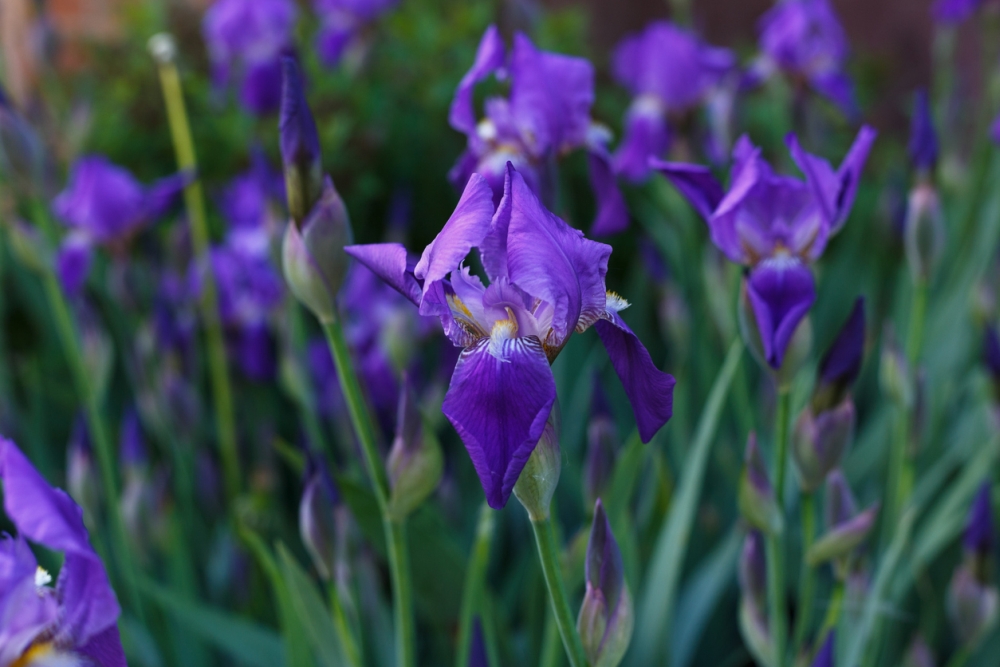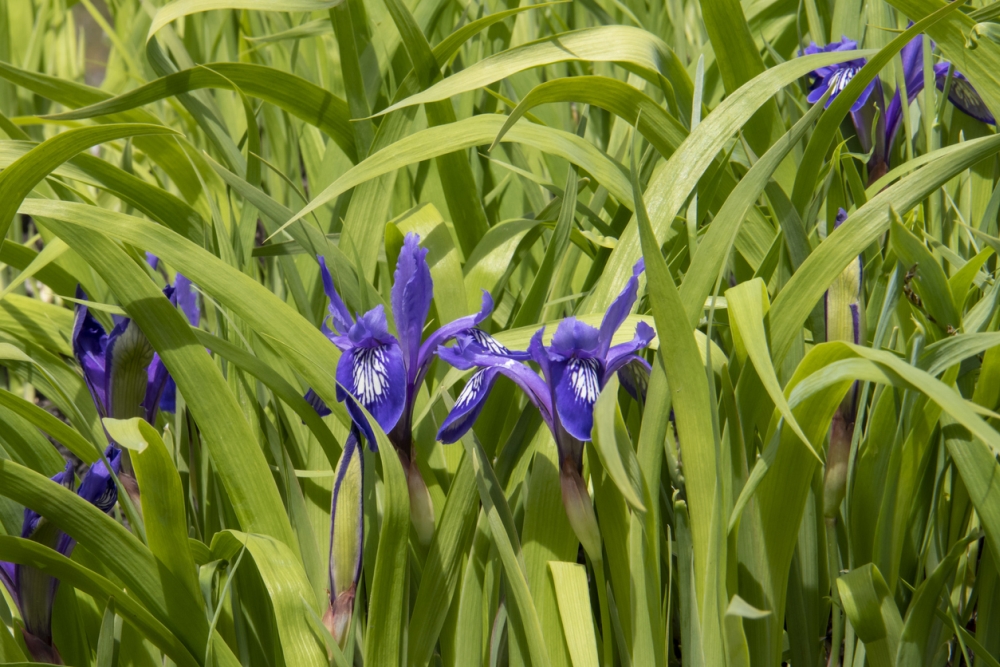Iris Growing Problems – Troubleshooting Common Irish Issues
Growing Iris can be the easiest thing in the world or the most troublesome gardening task, depending on who you ask. Some people grow any species of the flowery plant with no problems at all. And then there are those who can’t get the plant to go through a season disease-free. Maybe it’s just luck or the growing conditions. But it’s not just you. Irish growing problems are widespread and happen a lot.
Have a look at the list below to see if your iris problem is below. These growing issues are common to all varieties of iris.
Iris not Flowering
The first problem you might face growing an iris is when the plant won’t flower. And since their showy flowers are the pride and joy of every gardener, the absence of the blooms can be frustrating at times. But all is not lost. There are many reasons why the iris may not flower and many fixes to address each one.
- Rhizomes: Whether it grows out of a bulb or a rhizome, the iris uses it as a storage of nutrients and moisture to sustain the plant. So check the rhizome buried in the soil and see how healthy it is. If it’s deformed, scarred, smaller than usual, or looking mushy, then that’s why the iris is not flowering. Damage to the rhizome is often fatal.
- Soil: One of the main reasons the rhizome is mushy is because of poor drainage in the soil. If you’re growing the iris in clay or heavy soil, the plant may not bloom due to root rot or rhizome damage.
- Sun: The iris needs full sun to flower. It should get at least 6 hours of sunlight every day during the growing and flowering seasons.
- Depth of Medium: The rhizome or bulb of the plant should be close to the surface or even slightly breaching it. If the rhizome is too deep in the soil, the plant will not grow at a normal pace and the blooms might not appear.
How to Fix it
For every one of the above causes, you will have different approaches to fix it. Here are a few things you can do to address the lack of blooms on the iris. And remember, that patience is a virtue. Don’t give up on your irises that fast.
- If the rhizomes are too small, that could be a nutrition problem. Feed the plant with organic compost and a fertilizer high on phosphorus.
- A severely damaged or mushy rhizome means the plant will not survive. So you should uproot it and start a new iris.
- Make sure the soil is well-drained. Add perlite or coarse sand to heavy soil to improve its texture and drainage.
- If the iris is growing in partial shade, it will not flower. So bring the plant to a window sill that gets plenty of sunlight or remove any object that casts a shadow on the iris.
- Don’t plant the iris too deep in the soil. Make sure the rhizome is close to the surface and even slightly above it.
Iris Changing Color
The grandstanding iris demands your attention. Once the flowers open, they become the center of attention and the only show in town. And for good reasons. Between the bright colors and intricate designs, you could stare at them for hours on end without getting bored. So when the usually flashy colors start to change, you suspect foul play.
Usually, the colors of the iris would fade as a result of changes in the environment around it. For example, extreme heat or cold temperatures could drain the color of the flower. Another reason might be a transplant shock. If you’re not careful when repotting or transplanting the plant, the shock could cause its colors to fade.
A precocious dog or cat that likes to dig in the garden, could also scare the plant especially if the hole exposes the rhizome of the iris.
Another reason might be age. As the iris matures and nears its natural life, it will not bloom as regularly or abundantly as a young plant. The color of the flower on the aging iris will also change.
How to Fix it
If you can pinpoint the cause of the color change of the iris flower, then it will be easy to address it. Here are a few steps you can take.
- Make sure the iris is getting enough light. If you planted a small tree near the iris that might have cut off the sunlight, consider moving the tree to another spot.
- Test the pH of the soil and amend it to bring it to 6.8. Changes in the chemicals of the soil can impact the color of the flowers.
- Keep children and pets away from your iris batch. You might consider building a fence around the plants to prevent your pets from disturbing them.
- When repotting or transplanting the iris, avoid exposing the roots. That could cause a shock that results in the flowers changing their colors.
- If the iris is a cultivar, the parent with the stronger genes might take over. There’s nothing you can do about that. You might have a whole new iris all of a sudden.
Iris Leaf Spot
An ornamental plant like the iris has everything going for it. From showy flowers to lush green leaves. So when something happens to the leaves such as pests making holes in them or unsightly brown spots tarnish their beauty, you need to put on your detective hat and inspect the scene for clues.
Iris leaf spot is a fungal disease that infects plants where the soil is wet or humidity levels are high. At first, you’ll see small brown spots. These grow quickly and turn gray. Eventually, the leaf will die and drop. If left unchecked, the disease would spread to the buds and stems of the plant.
How to Fix it
There are times when the high humidity is beyond your control. For example, if it rains heavily and the soil gets wet and the air muggy, there’s little you can do to remedy the situation. If your irises are potted, then you can take them inside away from the rain. But the fate of those growing in the garden is up in the air.
Apart from unpredictable weather conditions, you need to make sure the soil is well-drained and that the airflow around the plants is optimal. If a plant gets infected with the fungus, you should dispose of it safely, mostly by burning it. Sterilize any gardening tools you used on the infected plant and apply a fungicide to eliminate the fungus spores hibernating in the soil.
Iris Borer Damage
Pests are another danger to the health and wellbeing of the iris. As much as we love to look at and admire our irises, pests see them as a valuable food source. A case in point is the iris borer which in reality is the larva of a moth. The Macronoctua onusta is a moth that lays its eggs in the fall and they will only hatch in April. That’s about the time when the first new leaves of the iris emerge. The hungry larvae crawl out and find the tender iris leaves waiting for them.
The larvae tunnel through the leaves and stems as they make their way to the rhizomes of the iris. Here they will find all the carbohydrates and minerals they need to grow and continue their life cycle. In their wake, you’ll notice dark streaks in the leaves and stems. As if that damage was not enough, the larvae also carry pathogens that cause the rhizomes to rot and die.
How to Fix it
Since the Macronoctua onusta moth is a nocturnal insect there’s little you can do to control it. But one of the best ways to deal with it is to plant an iris variety such as the Siberian iris with high resistance to the larvae.
Between April and May, you should examine your irises on a daily basis. Look for signs of larvae invasion. If you see holes or tunnels in the leaves and stems, remove the infected parts of the plant and burn them.
Keep the garden clean and debris-free in the fall to keep the moth from laying its eggs in your garden.
Spray a pesticide such as Spinosad in the early spring to kill the larvae before they reach the irises. Another application a couple of weeks later might be needed.
Yellow Flag Iris Control
The majority of the 300 iris species are wonderful ornamental plants to grow in your garden. But few of those are quite invasive. They still have showy flowers, but since they spread uninvited and take every inch of garden real estate you have, you should treat them as weeds and get rid of them. Even if they don’t grow in the garden, they’ll spread widely along the sides of streams and ponds blocking the water flow and disrupting the natural balance of the ecosystem.
How to Fix it
There’s no easy fix when the yellow flag iris takes over the land. The first thing you should do is not get it from the nursery and introduce it into your garden or landscape.
If you find a small batch of irises, you can dig them out by the roots and burn them. Don’t even have a fractured rhizome lying around because it will spring back to life and spread out in record times.
If you have a large infestation of yellow flag irises near your property, you should get professional help. The plants are notoriously hardy and stubborn. So it would be best to let the experts deal with it.
Iris Mosaic Control
The iris mosaic disease is caused by the mosaic virus which mainly targets bulbous irises. So if you’re growing Morocco, Spanish, or Dutch irises, your plants are susceptible to the disease. Symptoms include faded mosaic-like streaks on the green leaves. The flowers might also have dark spots that look like teardrops. The markings usually appear on blue, white, and lavender flowers. The flowers themselves will become smaller and less showy.
How to Fix it
The main carrier of the mosaic virus is aphids. These small insects are in almost every garden and household that has plants. So by eliminating these pests, you can ensure that your irises will stay healthy. That’s easier said than done though since the tiny insects are hard to detect.
- Spray the irises with neem oil as soon as you detect signs of aphid infestation.
- Get rid of infected plants or plant parts and burn them.
- Buy your plants from reliable sources.
- Remove weeds and debris from the garden to discourage aphids.

